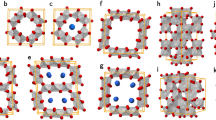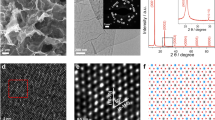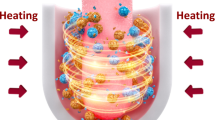Abstract
The oxygen evolution reaction (OER) is of prime importance in multiple energy storage devices; however, deeper mechanistic understanding is required to design enhanced electrocatalysts for the reaction. Current understanding of the OER mechanism based on oxygen adsorption on a metallic surface site fails to fully explain the activity of iridium and ruthenium oxide surfaces, and the drastic surface reconstruction observed for the most active OER catalysts. Here we demonstrate, using La2LiIrO6 as a model catalyst, that the exceptionally high activity found for Ir-based catalysts arises from the formation of active surface oxygen atoms that act as electrophilic centres for water to react. Moreover, with the help of transmission electron microscopy, we observe drastic surface reconstruction and iridium migration from the bulk to the surface. Therefore, we establish a correlation between surface activity and surface stability for OER catalysts that is rooted in the formation of surface reactive oxygen.
This is a preview of subscription content, access via your institution
Access options
Subscribe to this journal
Receive 12 digital issues and online access to articles
$119.00 per year
only $9.92 per issue
Buy this article
- Purchase on Springer Link
- Instant access to full article PDF
Prices may be subject to local taxes which are calculated during checkout






Similar content being viewed by others
Change history
14 July 2017
In the PDF version of this article previously published, the year of publication provided in the footer of each page and in the 'How to cite' section was erroneously given as 2017, it should have been 2016. This error has now been corrected. The HTML version of the article was not affected.
References
Dau, H. et al. The mechanism of water oxidation: from electrolysis via homogeneous to biological catalysis. Chem. Cat. Chem. 2, 724–761 (2010).
Hong, W. et al. Toward the rational design of non-precious transition metal oxides for oxygen electrocatalysis. Energy Environ. Sci. 8, 1404–1427 (2015).
Matsumoto, Y. & Sato, E. Electrocatalytic properties of transition metal oxides for oxygen evolution reaction. Mater. Chem. Phys. 14, 397–426 (1986).
Wattiaux, A. Electrolytic oxygen evolution in alkaline medium on La1−xSrxFeO3−y perovskite-related ferrites. J. Electrochem. Soc. 134, 1718–1724 (1987).
Bockris, J. O. & Otagawa, T. The electrocatalysis of oxygen evolution on perovskites. J. Electrochem. Soc. 131, 290–302 (1984).
Yagi, S. et al. Covalency-reinforced oxygen evolution reaction catalyst. Nat. Commun. 6, 8249 (2015).
Hardin, W. G. et al. Tuning the electrocatalytic activity of perovskites through active site variation and support interactions. Chem. Mater. 26, 3368–3376 (2014).
Suntivich, J., May, K. J., Gasteiger, H. A., Goodenough, J. B. & Shao-Horn, Y. A perovskite oxide optimized for oxygen evolution catalysis from molecular orbital principles. Science 334, 1383–1385 (2011).
Grimaud, A. et al. Double perovskites as a family of highly active catalysts for oxygen evolution in alkaline solution. Nat. Commun. 4, 2439 (2013).
Calle-Vallejo, F. et al. Number of outer electrons as descriptor for adsorption processes on transition metals and their oxides. Chem. Sci. 4, 1245–1249 (2013).
Trasatti, S. Electrocatalysis by oxides—attempt at a unifying approach. J. Electroanal. Chem. 111, 125–131 (1980).
Man, I. C. et al. Universality in oxygen evolution electrocatalysis on oxide surfaces. Chem. Cat. Chem. 3, 1159–1165 (2011).
Matsumoto, Y., Manabe, H. & Sato, E. Oxygen evolution on La1−xSrxCoO3 electrodes in alkaline solutions. J. Electrochem. Soc. 127, 811–814 (1980).
Betley, T. A., Wu, Q., Voorhis, T. & Van Nocera, D. G. Electronic design criteria for O–O bond formation via metal-oxo complexes. Inorg. Chem. 47, 1849–1861 (2008).
Risch, M. et al. Structural changes of cobalt-based perovskites upon water oxidation investigated by EXAFS. J. Phys. Chem. C 117, 8628–8635 (2013).
May, K. J. et al. Influence of oxygen evolution during water oxidation on the surface of perovskite oxide catalysts. J. Phys. Chem. Lett. 3, 3264–3270 (2012).
Binninger, T. et al. Thermodynamic explanation of the universal correlation between oxygen evolution activity and corrosion of oxide catalysts. Sci. Rep. 5, 12167 (2015).
Danilovic, N. et al. Using surface segregation to design stable Ru–Ir oxides for the oxygen evolution reaction in acidic environments. Angew. Chem. Int. Ed. Engl. 53, 14016–14021 (2014).
Chang, S. H. et al. Functional links between stability and reactivity of strontium ruthenate single crystals during oxygen evolution. Nat. Commun. 5, 4191 (2014).
Reier, T. et al. Molecular insight in structure and activity of highly efficient, low-Ir Ir–Ni oxide catalysts for electrochemical water splitting (OER). J. Am. Chem. Soc. 137, 13031–13040 (2015).
Cherevko, S. et al. Oxygen and hydrogen evolution reactions on Ru, RuO2, Ir, and IrO2 thin film electrodes in acidic and alkaline electrolytes: a comparative study on activity and stability. Catal. Today 262, 170–180 (2016).
Stoerzinger, K. A., Qiao, L., Biegalski, M. D. & Shao-horn, Y. Orientation-dependent oxygen evolution activities of rutile IrO2 and RuO2 . J. Phys. Chem. Lett. 118, 19733–19741 (2014).
Lee, Y., Suntivich, J., May, K. J., Perry, E. E. & Shao-horn, Y. Synthesis and activities of rutile IrO2 and RuO2 nanoparticles for oxygen evolution in acid and alkaline solutions. J. Phys. Chem. Lett. 3, 399–404 (2012).
Lyons, M. E. G. & Floquet, S. Mechanism of oxygen reactions at porous oxide electrodes. Part 2–Oxygen evolution at RuO2, IrO2 and IrxRu1−x)O2 electrodes in aqueous acid and alkaline solution. Phys. Chem. Chem. Phys. 13, 5314–5335 (2011).
Grimaud, A., Hong, W. T., Shao-Horn, Y. & Tarascon, J.-M. Anionic redox processes for electrochemical devices. Nat. Mater. 15, 121–126 (2016).
Saubanère, M., McCalla, E., Tarascon, J.-M. & Doublet, M.-L. The intriguing question of anionic redox in high-energy density cathodes for Li-ion batteries. Energy Environ. Sci. 9, 984–991 (2016).
Fierro, S., Nagel, T., Baltruschat, H. & Comninellis, C. Investigation of the oxygen evolution reaction on Ti/IrO2 electrodes using isotope labelling and on-line mass spectrometry. Electrochem. Commun. 9, 1969–1974 (2007).
Wohlfahrt-Mehrens, M. & Heitbaum, J. Oxygen evolution on Ru and RuO2 electrodes studied using isotope labelling and on-line mass spectrometry. J. Electroanal. Chem. 237, 251–260 (1987).
Surendranath, Y., Kanan, M. W. & Nocera, D. G. Mechanistic studies of the oxygen evolution reaction by a cobalt-phosphate catalyst at neutral pH. 45, 16501–16509 (2010).
Graeupner, J. et al. Probing the viability of oxo-coupling pathways in iridium-catalyzed oxygen evolution. Organometallics 32, 5384–5390 (2013).
Rong, X., Parolin, J. & Kolpak, A. M. A fundamental relationship between reaction mechanism and stability in metal oxide catalysts for oxygen evolution. ACS Catal. 6, 1153–1158 (2016).
Jung, D. Y., Demazeau, G. & Choy, J. H. Preparation under oxygen pressures of new perovskites: (ALa)LiIrO6−δ (A = Ca, Sr, Ba). High Press. Res. 15, 121–125 (1996).
Hayashi, K., Demazeau, G., Pouchard, M. & Hagenmuller, P. Preparation and magnetic study of a new iridium (V) perovskite: LaLi0.5Ir0.5O3 . Mater. Res. Bull. 15, 461–467 (1980).
Cherevko, S. et al. Dissolution of noble metals during oxygen evolution in acidic media. Chem. Cat. Chem. 6, 2219–2223 (2014).
Hodnik, N. et al. New insights into corrosion of ruthenium and ruthenium oxide nanoparticles in acidic media. J. Phys. Chem. C 119, 10140–10147 (2015).
Burke, L. D. & Murphy, O. J. Cyclic voltammetry as a technique for determining the surface area of RuO2 electrodes. J. Electroanal. Chem. 96, 19–27 (1979).
Minguzzi, A. et al. Observing the oxidation state turnover in heterogeneous iridium-based water oxidation catalysts. Chem. Sci. 5, 3591–3597 (2014).
Giordano, L. et al. pH dependence of OER activity of oxides: current and future perspectives. Catal. Today 262, 2–10 (2016).
Koper, M. T. M. Theory of multiple proton–electron transfer reactions and its implications for electrocatalysis. Chem. Sci. 4, 2710–2723 (2013).
Aydinol, M. K., Kohan, A. F. & Ceder, G. Ab initio study of lithium intercalation in metal oxides and metal dichalcogenides. Phys. Rev. B 56, 1354–1365 (1997).
Sathiya, M. et al. Reversible anionic redox chemistry in high-capacity layered-oxide electrodes. Nat. Mater. 12, 827–835 (2013).
McCalla, E. et al. Visualization and impact of O–O peroxo-like dimers in high capacity layered oxides for Li-ion batteries. Science 350, 1516–1521 (2015).
Yabuuchi, N., Yoshii, K., Myung, S., Nakai, I. & Komaba, S. Detailed studies of a high-capacity electrode material for rechargeable batteries, Li2MnO3–LiCo1∕3Ni1∕3Mn1∕3O2 . J. Am. Ceram. Soc. 133, 4404–4419 (2011).
Castel, E., Berg, E. J., El Kazzi, M., Nova, P. & Villevieille, C. Differential electrochemical mass spectrometry study of the interface of xLi2MnO3 â‹… (1 − x)LiMO2 (M = Ni, Co, and Mn) material as a positive electrode in Li-ion batteries. Chem. Mater. 26, 5051–5057 (2014).
Suntivich, J., Gasteiger, H. A., Yabuuchi, N. & Shao-Horn, Y. Electrocatalytic measurement methodology of oxide catalysts using a thin-film rotating disk electrode. J. Electrochem. Soc. 157, B1263–B1268 (2010).
Barthel, J. Dr. Probe - High-Resolution (S)TEM Image Simulation Software (Ernst Ruska-Centrum für Mikroscopie und Spektrocopie mit Elecktronen, 2016); http://www.er-c.org/barthel/drprobe
Kresse, G. & Furthmüller, J. Efficient iterative schemes for ab initio total-energy calculations using a plane-wave basis set. Phys. Rev. B 54, 11169–11186 (1996).
Kresse, G. & Hafner, J. Ab initio molecular dynamics for liquid metals. Phys. Rev. B 47, 558–561 (1993).
Perdew, J. P. & Wang, Y. Accurate and simple analytic representation of the electron-gas correlation energy. Phys. Rev. B 45, 13244–13249 (1992).
Dudarev, S. L., Botton, G. A., Savrasov, S. Y., Humphreys, C. J. & Sutton, A. P. Electron-energy-loss spectra and the structural stability of nickel oxide: an LSDA+U study. Phys. Rev. B 57, 1505–1509 (1998).
Maintz, S., Deringer, V. L., Tchougréeff, A. L. & Dronskowski, R. Analytic projection from plane-wave and PAW wavefunctions and application to chemical-bonding analysis in solids. J. Comput. Chem. 34, 2557–2567 (2013).
Deringer, V. L., Tchougr, A. L. & Dronskowski, R. Crystal orbital Hamilton population (COHP) analysis as projected from plane-wave basis sets. J. Phys. Chem. A 115, 5461–5466 (2011).
Dronskowski, R. & Bloechl, P. E. Crystal orbital Hamilton populations (COHP): energy-resolved visualization of chemical bonding in solids based on density-functional calculations. J. Phys. Chem. 97, 8617–8624 (1993).
Acknowledgements
We thank J. Barthel of Ernst Ruska-Centre (Forschungszentrum Jülich) for valuable discussions and his support for the HRTEM simulation using the Dr Probe software. We would like to thank D. Giaume (ENSCP) for the ICP measurements and D. Foix (IPREM) for the XPS measurements. We would also like to thank E. Berg (PSI) for the DEMS measurements. We acknowledge Diamond Light Source for time awarded to the Energy Materials BAG on Beamline B18, under proposal sp12559, as well as A. Chadwick and G. Cibin for assistance and discussions. The authors acknowledge financial support from the European Union under the 7th Framework Program under a contract for an Integrated Infrastructure Initiative reference 312483-ESTEEM2. We acknowledge funding from the European Research Council (ERC) (FP/2014)/ERC Grant-Project 670116-ARPEMA.
Author information
Authors and Affiliations
Contributions
A.G. designed the experiments. A.G. performed the synthesis, and structural and electrochemical analysis. A.D., W.D. and M.D. performed TEM measurements, atomic structural analyses and HRTEM image simulations. M.S. and M.-L.D. carried out the DFT calculations. A.G. and J.-M.T. wrote the manuscript, which all authors edited.
Corresponding author
Ethics declarations
Competing interests
The authors declare no competing financial interests.
Supplementary information
Supplementary Information
Supplementary Methods, Supplementary Discussion, Supplementary Tables 1–4, Supplementary Figures 1–20 and Supplementary References (PDF 2546 kb)
Rights and permissions
About this article
Cite this article
Grimaud, A., Demortière, A., Saubanère, M. et al. Activation of surface oxygen sites on an iridium-based model catalyst for the oxygen evolution reaction. Nat Energy 2, 16189 (2017). https://doi.org/10.1038/nenergy.2016.189
Received:
Accepted:
Published:
DOI: https://doi.org/10.1038/nenergy.2016.189
This article is cited by
-
In situ modulating coordination fields of single-atom cobalt catalyst for enhanced oxygen reduction reaction
Nature Communications (2024)
-
Continuous strain tuning of oxygen evolution catalysts with anisotropic thermal expansion
Nature Communications (2024)
-
A restricted dynamic surface self-reconstruction toward high-performance of direct seawater oxidation
Nature Communications (2024)
-
Structural, electrical, and optical features of Bi2FeCrO6 and Bi1.8La0.2FeCrO6 double perovskites for device applications
Journal of Materials Science: Materials in Electronics (2024)
-
Enriched electrophilic oxygen species facilitate acidic oxygen evolution on Ru-Mo binary oxide catalysts
Nano Research (2024)



